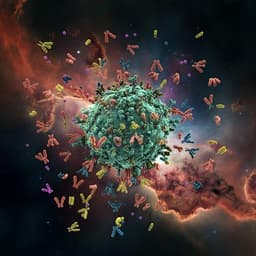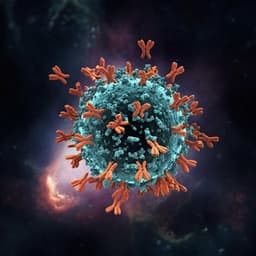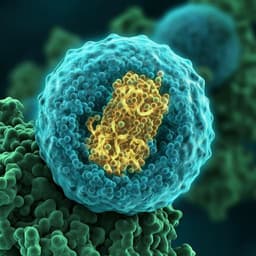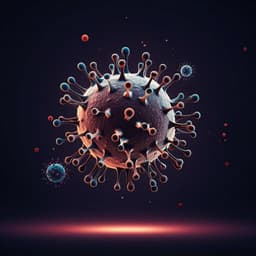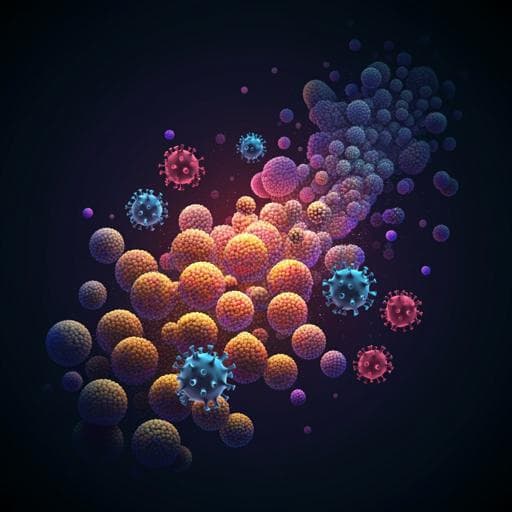
Medicine and Health
Quadrivalent mosaic HexaPro-bearing nanoparticle vaccine protects against infection of SARS-CoV-2 variants
Y. Kang, C. Sun, et al.
Innovative research led by Yin-Feng Kang and colleagues introduces a quadrivalent mosaic nanoparticle vaccine that shows promise against emerging SARS-CoV-2 variants. This vaccine elicits strong immune responses and offers protection against various strains, paving the way for enhanced multivalent vaccines to combat future viral threats.
~3 min • Beginner • English
Introduction
The study addresses the diminished effectiveness of vaccines based on the ancestral SARS-CoV-2 spike against emerging variants of concern (VOCs) such as Alpha, Beta, Gamma, Delta, and Omicron. Spike mutations in the receptor-binding domain (e.g., K417N/T, E484K/A, N501Y, L452R, T478K) alter antigenicity and can reduce neutralization by vaccine-induced sera. Multivalent nanoparticle vaccines can enhance humoral responses by multimeric antigen display. The authors propose a quadrivalent mosaic nanoparticle vaccine displaying HexaPro-stabilized spike ectodomains from the prototype and three VOCs to broaden and potentiate neutralizing antibody responses and provide cross-variant protection.
Literature Review
Prior work indicates that nanoparticle presentation of SARS-CoV-2 antigens (RBD or Spike) enhances immunogenicity compared to soluble antigens. Ferritin and two-component nanoparticles (e.g., 153-50) have been used successfully to display viral antigens. Mosaic display of diverse influenza HA antigens elicited broad protection, suggesting a strategy for coronaviruses. Studies showed vaccines remained effective against Alpha but exhibited reduced neutralization against Beta and Omicron; Delta showed partial escape. An mRNA vaccine using a Beta spike improved Beta-specific neutralization in NHPs. Mosaic RBD nanoparticles elicited cross-sarbecovirus responses in animals. These findings motivate multivalent, mosaic spike-based nanoparticle vaccines to address variant escape.
Methodology
Design: HexaPro-stabilized spike ectodomains (residues 16–1138, with six prolines and GSAS at furin site) from SARS-CoV-2 prototype and three VOCs (Alpha B.1.1.7, Beta B.1.351, Gamma P.1) were genetically fused to the N-terminus of trimeric 153-50A1 via flexible (GGSGGSGSGGSGGSGS) and rigid (EKAAKAEEAARK) linkers to form HexaPro-153-50A1. These were co-assembled in vitro with pentameric 153-50B.4PT1 to generate icosahedral nanoparticles. Immunogen formats: WT NP (prototype only), Alpha NP, Beta NP, Gamma NP; Cocktail NP (equimolar mix of four monovalent NPs); Mosaic NP (in situ co-display of the four HexaPro variants on a single NP). Expression/Purification: HexaPro constructs expressed in Expi293F cells, purified by IMAC and SEC; 153-50 components expressed in E. coli, purified as reported; endotoxin removal and quantification performed. Characterization: Negative-stain EM to verify nanoparticle assembly; SEC and DLS to assess homogeneity and size; immunoprecipitation with broadly neutralizing RBM mAb S2-E12; ELISA binding against a panel of anti-spike mAbs; BLI to determine binding to hACE2 and antigenicity; DSF to evaluate thermostability and aggregation (Tm, Tagg). Immunizations: Mice (BALB/c) received subcutaneous doses at weeks 0 and 3 of either 5 µg soluble WT HexaPro, or 6.5 µg NP immunogens (equimolar to 5 µg HexaPro) formulated with MF59-like adjuvant; sera collected 2 weeks post-prime and post-boost. Cynomolgus macaques (n=8, two groups of 4) received intramuscular 65 µg WT NP or Mosaic NP with MF59-like adjuvant at weeks 0, 4, 8; sera collected biweekly to week 10. Assays: ELISA endpoint binding titers against HexaPro antigens (WT, Alpha, Beta, Gamma, Delta, Eta). Pseudovirus neutralization assays (HIV-based) against prototype, VOCs (Alpha, Beta, Gamma, Delta, Omicron), VOIs (Eta, Lambda), RBD single/combo mutations (K417N/T, L452R/Q, T478K/R, E484A/K/Q, N501Y, combinations), and other coronaviruses (SARS-CoV, MERS-CoV, HCoV-OC43, HCoV-NL63, HCoV-229E, RaTG13). Authentic virus neutralization (CPE-based NT50) against prototype and variants (Alpha, Beta, Gamma, Delta, Eta). BLI ACE2-competition using pooled macaque sera at peak potency (1:1000). Challenge studies: BALB/c mice challenged with SARS-CoV-2 B.1.351 without Ad5-hACE2 (susceptible model) and with prototype after Ad5-hACE2 transduction, 4 weeks post-boost. Outcomes measured: body weight, lung viral titers by focus-forming assay (FFU/g), qRT-PCR copies (ORF1ab, N), lung histopathology (H&E) and IHC for viral antigen, and lung cytokine/chemokine mRNA levels (IFIT1, IFIT3, ISG15, MX2, IL6, IL10, CXCL10, CCL2). Statistics: Mann-Whitney U for binding and neutralization; Kruskal–Wallis with Dunn’s for cytokines and viral copies; p<0.05 significant.
Key Findings
- Antigen display and integrity: EM confirmed icosahedral nanoparticles with surface spikes; S2-E12 immunoprecipitated all HexaPro formats. Mosaic NP bound a broad panel of NTD/RBD mAbs, indicating preserved antigenicity. All NPs showed homogeneous SEC/DLS profiles; similar thermostability to HexaPro, though Gamma NP and Mosaic NP exhibited an additional Tm ~45 °C coincident with aggregation onset. All NPs bound ACE2 with comparable apparent affinity.
- Mouse immunogenicity (ELISA): After prime, WT NP elicited higher binding to WT HexaPro vs soluble WT; Mosaic NP elicited higher binding to Beta, Gamma, Delta, Eta vs soluble WT. After boost, Mosaic NP induced higher endpoint titers against WT, Alpha, Beta, Gamma, Delta, Eta (e.g., Mosaic NP median titers ~10^5.5, 10^5.2, 10^5.1, 10^5.4, 10^5.2, 10^6.0) representing 2–12.6-fold increases vs soluble WT HexaPro.
- Mouse neutralization (pseudovirus): Post-prime, Mosaic NP sera ID50 were 7.9–631-fold higher than soluble WT across prototype and variants (e.g., prototype 10^3.9±0.3 vs 10^1.7±0.2; Beta 10^4.1±0.2 vs 10^1.6; Gamma 10^4.4±0.2 vs 10^1.6). WT NP, Cocktail NP, and Mosaic NP showed similar titers to each other. Post-boost, overall titers rose; significant advantages mainly for Gamma and Eta.
- Mouse neutralization (authentic virus): Mosaic NP elicited 4–20-fold higher NT50 vs soluble WT against Beta, Gamma, Eta after prime and boost. Cocktail NP and Mosaic NP were equivalent or superior to WT NP against prototype, Alpha, Delta. Neutralization against VOCs and VUMs remained high and stable across time points.
- NHP immunogenicity: Mosaic NP showed slightly lower autologous (prototype) binding/neutralization titers than WT NP through week 10 but higher titers against variants (Alpha, Beta, Gamma, Delta, Eta) across time points; differences generally not statistically significant. At 2 weeks post-2nd boost, authentic virus NT50 against Beta, Gamma, Eta were ~3.2–4-fold higher in Mosaic NP vs WT NP (e.g., Beta 10^3.2±0.2 vs 10^2.7±0.3; Gamma 10^3.5±0.3 vs 10^2.9±0.2; Eta 10^3.3±0.4 vs 10^2.8±0.4). Neutralization titers increased after first two doses and plateaued after third.
- Variant/mutation breadth in NHPs (peak): Omicron and Lambda reduced WT NP sera potency (Omicron ID50 ~10^3.3±0.2; Lambda ~10^3.9±0.4), corresponding to ~20-fold and 5-fold drops vs prototype, but only slightly reduced Mosaic NP sera (Omicron ~10^3.9±0.1; Lambda ~10^4.1±0.4). D614G slightly increased neutralization (WT NP 10^4.4±0.2; Mosaic NP 10^4.9±0.5). Single RBD substitutions K417N/T, N501Y, L452R, E484Q had modest effects; E484K caused a 3.2-fold (WT NP) and 2.0-fold (Mosaic NP) reduction vs D614G, indicating greater resistance for WT NP. Combination mutations (e.g., K417N+E484K+N501Y; L452R+T478K; L452R+E484Q) reduced titers vs D614G, yet Mosaic NP sera retained high neutralization. Mosaic NP sera showed higher cross-neutralization of SARS-related pseudoviruses (SARS-CoV, MERS-CoV, HCoVs, RaTG13) than WT NP.
- ACE2 competition (BLI): At 1:1000 dilution, Mosaic NP macaque sera more effectively blocked ACE2 binding to WT, Alpha, Beta, and Gamma HexaPro than WT NP sera; less so for Delta and Eta.
- Mouse protection (B.1.351 challenge): Vaccinated groups prevented body weight loss seen in PBS controls (PBS peak loss ~14.6% by day 4). No infectious virions detected by FFA in lungs of vaccinated mice at day 2 post-challenge. Lung viral RNA copies (ORF1ab) reduced vs PBS by ~10^4.0 (WT HexaPro), 10^4.4 (WT NP), 10^4.4 (Cocktail NP), and 10^4.7 (Mosaic NP) fold; N gene similar. Vaccination reduced lung inflammatory cytokine/chemokine transcripts and limited pathology and viral antigen by histology/IHC. Protection also observed against prototype challenge in Ad5-hACE2-transduced mice.
Discussion
The quadrivalent mosaic HexaPro-bearing nanoparticle effectively broadens and enhances neutralizing antibody responses against multiple SARS-CoV-2 variants compared to a prototype-only nanoparticle or soluble spike. The multivalent, in situ mosaic display likely promotes B cell activation against conserved and variable epitopes across spike variants, improving breadth with minimal compromise to ancestral strain neutralization. In mice and cynomolgus macaques, Mosaic NP elicited equal or superior binding and neutralization against Alpha, Beta, Gamma, Delta, Eta, and maintained better potency against Omicron and Lambda than WT NP. Challenge studies demonstrated robust protection against Beta and prototype viruses, with marked reductions in lung viral loads, inflammation, and pathology. While many differences versus WT NP or Cocktail NP were modest and not always statistically significant (likely due to limited group sizes), consistent trends favor Mosaic NP, supporting mosaic multivalent antigen design to counter immune escape and potential pre-emergent variants. The plateau after the third dose suggests two-dose regimens may suffice for strong neutralization with this platform.
Conclusion
This work presents a quadrivalent mosaic nanoparticle vaccine displaying HexaPro spikes from SARS-CoV-2 prototype and three VOCs (Alpha, Beta, Gamma). The vaccine is structurally sound, antigenically intact, and elicits potent, broad neutralizing antibodies in mice and macaques, with improved resilience to key RBD mutations and variants, including Omicron. In mice, it confers protection against Beta and prototype challenges, reducing viral burden and pathology. The findings provide proof-of-principle for multivalent mosaic spike nanoparticle vaccines to address circulating and emerging SARS-CoV-2 variants. Future work should include larger animal studies and clinical trials to confirm efficacy, optimization of antigen composition (e.g., inclusion of Omicron-class spikes), dose-sparing strategies, assessment of durability and cellular immunity, and evaluation against current and future variants.
Limitations
- Sample sizes were limited (mice groups n≈6 for immunogenicity, n=4 per macaque group), reducing statistical power; many differences did not reach significance.
- Non-human primate studies did not include viral challenge; protection data are from mouse models only.
- Omicron was assessed in pseudovirus assays; authentic virus neutralization for Omicron was not reported.
- Some thermostability/aggregation features were observed for Gamma-containing nanoparticles (additional Tm ~45 °C), which may affect formulation stability.
- ACE2 binding and mass-transport effects in BLI for large nanoparticles may complicate direct affinity comparisons.
- The antigen set did not include later variants beyond those tested; real-world breadth against future variants remains to be confirmed.
Related Publications
Explore these studies to deepen your understanding of the subject.



